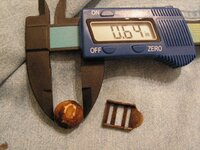RJH02
Sr. Member
- Dec 30, 2007
- 438
- 9
- Detector(s) used
- Silver umax w/ 7in Deep Search Wide scan coil
- Primary Interest:
- Relic Hunting
I found this today in the woods behind my house, it seems much larger than the others I have found and I havent seen many posted on here. Is this a rare size or are they pretty common?I found the buckle just a few feet away, Thanks



 OK just being silly today.
OK just being silly today. 



